Over-Expressing TaSPA-B Reduces Prolamin and Starch Accumulation in Wheat (Triticum aestivum L.) Grains
Abstract
1. Introduction
2. Results
2.1. Generating TaSPA-B Overexpressing Lines
2.2. Morphology of Starch and Prolamin in Mature Seeds
2.3. Starch and Prolamin Contents
2.4. Relative Expression Analysis of TaSPA and Prolamin Genes
2.5. Identification and Annotation of Differentially Expressed Genes in the TaSPA-B OE-3 Immature Seeds
2.6. DEGs Involved in Starch and Protein Metabolism
2.7. Dual-Luciferase Reporter Assay of the ω-1,2 Gliadin Gene Promoter
3. Discussion
4. Materials and Methods
4.1. Plant Materials
4.2. DNA Extraction, RNA Extraction, cDNA Synthesis, and qRT-PCR
4.3. Plasmid Construction and Genetic Transformation for Wheat
4.4. Extraction and Size Distribution of Starch Granules, and Morphology Observation
4.5. Starch and Protein Extraction and Content Analysis
4.6. RNA-Seq Analysis
4.7. Dual-Luciferase Reporter Assay of Gliadin Gene Promoter Activations
4.8. Statistical Analysis
Supplementary Materials
Author Contributions
Funding
Acknowledgments
Conflicts of Interest
References
- Rustgi, S.; Shewry, P.; Brouns, F.; Deleu, L.J.; Delcour, J.A. Wheat Seed Proteins: Factors Influencing Their Content, Composition, and Technological Properties, and Strategies to Reduce Adverse Reactions. Compr. Rev. Food Sci. Food Saf. 2019, 18, 1751–1769. [Google Scholar] [CrossRef]
- Wang, D.; Li, F.; Cao, S.; Zhang, K. Genomic and functional genomics analyses of gluten proteins and prospect for simultaneous improvement of end-use and health-related traits in wheat. Theor. Appl. Genet. 2020, 10–1007. [Google Scholar] [CrossRef] [PubMed]
- Kumar, R.; Mukherjee, S.; Ayele, B.T. Molecular aspects of sucrose transport and its metabolism to starch during seed development in wheat: A comprehensive review. Biotechnol. Adv. 2018, 36, 954–967. [Google Scholar] [CrossRef] [PubMed]
- Peng, M.; Gao, M.; Abdel Aal, E.S.M.; Hucl, P.; Chibbar, R.N. Separation and Characterization of A- and B- Type Starch Granules in Wheat Endosperm. Cereal Chem. 1999, 76, 375–379. [Google Scholar] [CrossRef]
- Tosi, P. Trafficking and deposition of prolamins in wheat. J. Cereal Sci. 2012, 56, 81–90. [Google Scholar] [CrossRef]
- Kawakatsu, T.; Takaiwa, F. Cereal seed storage protein synthesis: Fundamental processes for recombinant protein production in cereal grains. Plant Biotechnol. J. 2010, 8, 939–953. [Google Scholar] [CrossRef]
- Verdier, J.; Thompson, R.D. Transcriptional Regulation of Storage Protein Synthesis During Dicotyledon Seed Filling. Plant Cell Physiol. 2008, 49, 1263–1271. [Google Scholar] [CrossRef]
- Xi, D.; Zheng, C. Transcriptional regulation of seed storage protein genes in Arabidopsis and cereals. Seed Sci. Res. 2011, 21, 247–254. [Google Scholar] [CrossRef]
- Kang, G.; Xu, W.; Liu, G.; Peng, X.; Guo, T. Comprehensive analysis of the transcription of starch synthesis genes and the transcription factor RSR1 in wheat (Triticum aestivum L.) endosperm. Genome 2013, 56, 115–122. [Google Scholar] [CrossRef]
- Fu, F.; Xue, H. Coexpression Analysis Identifies Rice Starch Regulator1, a Rice AP2/EREBP Family Transcription Factor, as a Novel Rice Starch Biosynthesis Regulator. Plant Physiol. 2010, 154, 927–938. [Google Scholar] [CrossRef]
- Maddaloni, M.; Donini, G.; Balconi, C.; Rizzi, E.; Gallusci, P.; Forlani, F.; Lohmer, S.; Thompson, R.; Salamini, F.; Motto, M. The transcriptional activator Opaque-2 controls the expression of a cytosolic form of pyruvate orthophosphate dikinase-1 in maize endosperms. Mol. Gen. Genet. 1996, 250, 647–654. [Google Scholar] [CrossRef]
- She, K.; Kusano, H.; Koizumi, K.; Yamakawa, H.; Hakata, M.; Imamura, T.; Fukuda, M.; Naito, N.; Tsurumaki, Y.; Yaeshima, M.; et al. A Novel Factor FLOURY ENDOSPERM2 Is Involved in Regulation of Rice Grain Size and Starch Quality. Plant Cell 2010, 22, 3280–3294. [Google Scholar] [CrossRef] [PubMed]
- Kumar, P.; Mishra, A.; Sharma, H.; Sharma, D.; Rahim, M.S.; Sharma, M.; Parveen, A.; Jain, P.; Verma, S.K.; Rishi, V.; et al. Pivotal role of bZIPs in amylose biosynthesis by genome survey and transcriptome analysis in wheat (Triticum aestivum L.) mutants. Sci. Rep. 2018, 8, 17240. [Google Scholar] [CrossRef] [PubMed]
- Hwang, Y.S.; Ciceri, P.; Parsons, R.L.; Moose, S.P.; Schmidt, R.J.; Huang, N. The maize O2 and PBF proteins act additively to promote transcription from storage protein gene promoters in rice endosperm cells. Plant Cell Physiol. 2004, 45, 1509–1518. [Google Scholar] [CrossRef] [PubMed]
- Yamamoto, M.P.; Onodera, Y.; Touno, S.M.; Takaiwa, F. Synergism between RPBF Dof and RISBZ1 bZIP Activators in the Regulation of Rice Seed Expression Genes. Plant Physiol. 2006, 141, 1694–1707. [Google Scholar] [CrossRef] [PubMed]
- Moreno-Risueno, M.Á.; González, N.; Díaz, I.; Parcy, F.; Carbonero, P.; Vicente-Carbajosa, J. FUSCA3 from barley unveils a common transcriptional regulation of seed-specific genes between cereals and Arabidopsis. Plant J. 2008, 53, 882–894. [Google Scholar] [CrossRef] [PubMed]
- Sun, F.; Liu, X.; Wei, Q.; Liu, J.; Yang, T.; Jia, L.; Wang, Y.; Yang, G.; He, G. Functional Characterization of TaFUSCA3, a B3-Superfamily Transcription Factor Gene in the Wheat. Front. Plant Sci. 2017, 8, 1133. [Google Scholar] [CrossRef]
- Diaz, I.; Vicente-Carbajosa, J.; Abraham, Z.; Martinez, M.; Isabel-La, M.I.; Carbonero, P. The GAMYB protein from barley interacts with the DOF transcription factor BPBF and activates endosperm-specific genes during seed development. Plant J. 2002, 29, 453–464. [Google Scholar] [CrossRef]
- Guo, W.; Yang, H.; Liu, Y.; Gao, Y.; Ni, Z.; Peng, H.; Xin, M.; Hu, Z.; Sun, Q.; Yao, Y. The wheat transcription factor TaGAMyb recruits histone acetyltransferase and activates the expression of a high-molecular-weight glutenin subunit gene. Plant J. 2015, 84, 347–359. [Google Scholar] [CrossRef]
- Rubio-Somoza, I.; Martinez, M.; Abraham, Z.; Diaz, I.; Carbonero, P. Ternary complex formation between HvMYBS3 and other factors involved in transcriptional control in barley seeds. Plant J. 2006, 47, 269–281. [Google Scholar] [CrossRef]
- Rubio-Somoza, I.; Martinez, M.; Diaz, I.; Carbonero, P. HvMCB1, a R1MYB transcription factor from barley with antagonistic regulatory functions during seed development and germination. Plant J. 2006, 45, 17–30. [Google Scholar] [CrossRef]
- She, M.; Ye, X.; Yan, Y.; Howit, C.; Belgard, M.; Ma, W. Gene networks in the synthesis and deposition of protein polymers during grain development of wheat. Funct. Integr. Genom. 2011, 11, 23–35. [Google Scholar] [CrossRef] [PubMed]
- Wang, J.; Xu, H.; Zhu, Y.; Liu, Q.; Cai, X. OsbZIP58, a basic leucine zipper transcription factor, regulates starch biosynthesis in rice endosperm. J. Exp. Bot. 2013, 64, 3453–3466. [Google Scholar] [CrossRef] [PubMed]
- Zhang, Z.; Dong, J.; Ji, C.; Wu, Y.; Messing, J. NAC-type transcription factors regulate accumulation of starch and protein in maize seeds. Proc. Natl. Acad. Sci. USA 2019, 116, 11223–11228. [Google Scholar] [CrossRef] [PubMed]
- Liu, G.; Wu, Y.; Xu, M.; Gao, T.; Wang, P.; Wang, L.; Guo, T.; Kang, G. Virus-Induced Gene Silencing Identifies an Important Role of the TaRSR1 Transcription Factor in Starch Synthesis in Bread Wheat. Int. J. Mol. Sci. 2016, 17, 1557. [Google Scholar] [CrossRef]
- Song, Y.; Luo, G.; Shen, L.; Yu, K.; Yang, W.; Li, X.; Sun, J.; Zhan, K.; Cui, D.; Liu, D.; et al. TubZIP28, a novel bZIP family transcription factor from Triticum urartu, and TabZIP28, its homologue from Triticum aestivum, enhance starch synthesis in wheat. New Phytol. 2020. [Google Scholar] [CrossRef]
- Zhan, J.; Li, G.; Ryu, C.; Ma, C.; Zhang, S.; Lloyd, A.; Hunter, B.G.; Larkins, B.A.; Drews, G.N.; Wang, X.; et al. Opaque-2 Regulates a Complex Gene Network Associated with Cell Differentiation and Storage Functions of Maize Endosperm. Plant Cell 2018, 30, 2425–2446. [Google Scholar] [CrossRef]
- Zhang, Z.; Zheng, X.; Yang, J.; Messing, J.; Wu, Y. Maize endosperm-specific transcription factors O2 and PBF network the regulation of protein and starch synthesis. Proc. Natl. Acad. Sci. USA 2016, 113, 10842–10847. [Google Scholar] [CrossRef] [PubMed]
- Kawakatsu, T.; Yamamoto, M.P.; Touno, S.M.; Yasuda, H.; Takaiwa, F. Compensation and interaction between RISBZ1 and RPBF during grain filling in rice. Plant J 2009, 59, 908–920. [Google Scholar] [CrossRef]
- Kim, J.S.; Chae, S.; Jun, K.M.; Pahk, Y.; Lee, T.; Chung, P.J.; Kim, Y.; Nahm, B.H. Genome-wide identification of grain filling genes regulated by the OsSMF1 transcription factor in rice. Rice 2017, 10, 16. [Google Scholar] [CrossRef]
- Barro, F.; Iehisa, J.C.M.; Giménez, M.J.; García-Molina, M.D.; Ozuna, C.V.; Comino, I.; Sousa, C.; Gil-Humanes, J. Targeting of prolamins by RNAi in bread wheat: Effectiveness of seven silencing-fragment combinations for obtaining lines devoid of coeliac disease epitopes from highly immunogenic gliadins. Plant Biotechnol. J. 2016, 14, 986–996. [Google Scholar] [CrossRef] [PubMed]
- Blechl, A.E.; Anderson, O.D. Expression of a novel high-molecular-weight glutenin subunit gene in transgenic wheat. Nat. Biotechnol. 1996, 14, 875–879. [Google Scholar] [CrossRef] [PubMed]
- Boudet, J.; Merlino, M.; Plessis, A.; Gaudin, J.; Dardevet, M.; Perrochon, S.; Alvarez, D.; Risacher, T.; Martre, P.; Ravel, C. The bZIP transcription factor SPA Heterodimerizing Protein represses glutenin synthesis inTriticum aestivum. Plant J. 2019, 97, 858–871. [Google Scholar] [CrossRef] [PubMed]
- Zhu, J.; Fang, L.; Yu, J.; Zhao, Y.; Chen, F.; Xia, G. 5-Azacytidine treatment and TaPBF-D over-expression increases glutenin accumulation within the wheat grain by hypomethylating the Glu-1 promoters. Theor. Appl. Genet. 2018, 131, 735–746. [Google Scholar] [CrossRef] [PubMed]
- Li, C.; Qiao, Z.; Qi, W.; Wang, Q.; Yuan, Y.; Yang, X.; Tang, Y.; Mei, B.; Lv, Y.; Zhao, H.; et al. Genome-Wide Characterization of cis-Acting DNA Targets Reveals the Transcriptional Regulatory Framework of Opaque2 in Maize. Plant Cell 2015, 27, 532–545. [Google Scholar] [CrossRef] [PubMed]
- Albani, D.; Hammond-Kosack, M.C.; Smith, C.; Conlan, S.; Colot, V.; Holdsworth, M.; Bevan, M.W. The wheat transcriptional activator SPA: A seed-specific bZIP protein that recognizes the GCN4-like motif in the bifactorial endosperm box of prolamin genes. Plant Cell 1997, 9, 171–184. [Google Scholar] [CrossRef]
- Ravel, C.; Martre, P.; Romeuf, I.; Dardevet, M.; El-Malki, R.; Bordes, J.; Duchateau, N.; Brunel, D.; Balfourier, F.; Charmet, G. Nucleotide Polymorphism in the Wheat Transcriptional Activator Spa Influences Its Pattern of Expression and Has Pleiotropic Effects on Grain Protein Composition, Dough Viscoelasticity, and Grain Hardness. Plant Physiol. 2009, 151, 2133–2144. [Google Scholar] [CrossRef]
- Ravel, C.; Fiquet, S.; Boudet, J.; Dardevet, M.; Vincent, J.; Merlino, M.; Michard, R.; Martre, P. Conserved cis-regulatory modules in promoters of genes encoding wheat high-molecular-weight glutenin subunits. Front. Plant Sci. 2014, 5, 621. [Google Scholar] [CrossRef]
- Li, J.; Wang, K.; Li, G.; Li, Y.; Zhang, Y.; Liu, Z.; Ye, X.; Xia, X.; He, Z.; Cao, S. Dissecting conserved cis-regulatory modules of Glu-1 promoters which confer the highly active endosperm-specific expression via stable wheat transformation. Crop J. 2019, 7, 8–18. [Google Scholar] [CrossRef]
- Guillaumie, S.; Charmet, G.; Linossier, L.; Torney, V.; Robert, N.; Ravel, C. Colocation between a gene encoding the bZip factor SPA and an eQTL for a high-molecular-weight glutenin subunit in wheat (Triticum aestivum). Genome 2004, 47, 705–713. [Google Scholar] [CrossRef]
- Long, H.; Wei, Y.; Yan, Z.; Baum, B.; Nevo, E.; Zheng, Y. Analysis and validation of genome-specific DNA variations in 5’ flanking conserved sequences of wheat low-molecular-weight glutenin subunit genes. Sci. China Ser. C Life Sci. 2006, 49, 322–331. [Google Scholar] [CrossRef] [PubMed]
- Van Herpen, T.W.J.M.; Riley, M.; Sparks, C.; Jones, H.D.; Gritsch, C.; Dekking, E.H.; Hamer, R.J.; Bosch, D.; Salentijn, E.M.J.; Smulders, M.J.M.; et al. Detailed Analysis of the Expression of an Alpha-gliadin Promoter and the Deposition of Alpha-gliadin Protein During Wheat Grain Development. Ann. Bot. 2008, 102, 331–342. [Google Scholar] [CrossRef] [PubMed]
- Pistón, F.; Marín, S.; Hernando, A.; Barro, F. Analysis of the activity of a γ-gliadin promoter in transgenic wheat and characterization of gliadin synthesis in wheat by MALDI-TOF during grain development. Mol. Breed. 2009, 23, 655–667. [Google Scholar] [CrossRef]
- Vincentz, M.; Bandeira-Kobarg, C.; Gauer, L.; Schlögl, P.; Leite, A. Evolutionary Pattern of Angiosperm bZIP Factors Homologous to the Maize Opaque2 Regulatory Protein. J. Mol. Evol. 2003, 56, 105–116. [Google Scholar] [CrossRef] [PubMed]
- Onodera, Y.; Suzuki, A.; Wu, C.; Washida, H.; Takaiwa, F. A Rice Functional Transcriptional Activator, RISBZ1, Responsible for Endosperm-specific Expression of Storage Protein Genes through GCN4 Motif. J. Biol. Chem. 2001, 276, 14139–14152. [Google Scholar] [CrossRef]
- Plessis, A.; Ravel, C.; Bordes, J.; Balfourier, F.; Martre, P. Association study of wheat grain protein composition reveals that gliadin and glutenin composition are trans-regulated by different chromosome regions. J. Exp. Bot. 2013, 64, 3627–3644. [Google Scholar] [CrossRef]
- Singh, A.; Kumar, P.; Sharma, M.; Tuli, R.; Dhaliwal, H.S.; Chaudhury, A.; Pal, D.; Roy, J. Expression patterns of genes involved in starch biosynthesis during seed development in bread wheat (Triticum aestivum). Mol. Breed. 2015, 35, 184. [Google Scholar] [CrossRef]
- Howard, T.; Rejab, N.A.; Griffiths, S.; Leigh, F.; Leverington-Waite, M.; Simmonds, J.; Uauy, C.; Trafford, K. Identification of a major QTL controlling the content of B-type starch granules in Aegilops. J. Exp. Bot. 2011, 62, 2217–2228. [Google Scholar] [CrossRef]
- Lindeboom, N.; Chang, P.R.; Tyler, R.T. Analytical, biochemical and physicochemical aspects of starch granule size, with emphasis on small granule starches: A review. Starch-Starke 2004, 56, 89–99. [Google Scholar] [CrossRef]
- Zheng, Y.; Wang, Z. Protein accumulation in aleurone cells, sub-aleurone cells and the center starch endosperm of cereals. Plant Cell Rep. 2014, 33, 1607–1615. [Google Scholar] [CrossRef]
- Méchin, V.; Thévenot, C.; Le Guilloux, M.; Prioul, J.; Damerval, C. Developmental Analysis of Maize Endosperm Proteome Suggests a Pivotal Role for Pyruvate Orthophosphate Dikinase. Plant Physiol. 2007, 143, 1203–1219. [Google Scholar] [CrossRef] [PubMed]
- Manicacci, D.; Camus-Kulandaivelu, L.; Fourmann, M.; Arar, C.; Barrault, S.; Rousselet, A.; Feminias, N.; Consoli, L.; Francès, L.; Méchin, V.; et al. Epistatic Interactions between Opaque2 Transcriptional Activator and Its Target Gene CyPPDK1 Control Kernel Trait Variation in Maize. Plant Physiol. 2009, 150, 506–520. [Google Scholar] [CrossRef] [PubMed]
- Zhang, L.; Zhao, L.; Lin, L.; Zhao, L.; Liu, Q.; Wei, C. A Novel Mutation of OsPPDKB, Encoding Pyruvate Orthophosphate Dikinase, Affects Metabolism and Structure of Starch in the Rice Endosperm. Int. J. Mol. Sci. 2018, 19, 2268. [Google Scholar] [CrossRef] [PubMed]
- Satoh, H.; Shibahara, K.; Tokunaga, T.; Nishi, A.; Tasaki, M.; Hwang, S.; Okita, T.W.; Kaneko, N.; Fujita, N.; Yoshida, M.; et al. Mutation of the Plastidial α-Glucan Phosphorylase Gene in Rice Affects the Synthesis and Structure of Starch in the Endosperm. Plant Cell 2008, 20, 1833–1849. [Google Scholar] [CrossRef]
- Sun, C.; Yang, F.; Zhang, T.; Sui, X.; Liang, R.; Liu, Q.; Zhang, X.; Li, B. Down-Regulation of the Expression of Grain ppo Genes to Improve Wheat Dough Whiteness by RNA Interference. Sci. Agric. Sin. 2013, 46, 1104–1113. [Google Scholar] [CrossRef]
- Wang, K.; Liu, H.; Du, L.; Ye, X. Generation of marker-free transgenic hexaploid wheat via an Agrobacterium-mediated co-transformation strategy in commercial Chinese wheat varieties. Plant Biotechnol. J. 2017, 15, 614–623. [Google Scholar] [CrossRef]
- Han, C.; Lu, X.; Yu, Z.; Li, X.; Ma, W.; Yan, Y. Rapid separation of seed gliadins by reversed-phase ultra performance liquid chromatography (RP-UPLC) and its application in wheat cultivar and germplasm identification. Biosci. Biotechnol. Biochem. 2015, 79, 808–815. [Google Scholar] [CrossRef]
- Yan, X.; Liu, W.; Yu, Z.; Han, C.; Zeller, F.J.; Hsam, S.L.K.; Yan, Y. Rapid separation and identification of wheat HMW glutenin subunits by UPLC and comparative analysis with HPLC. Aust. J. Crop Sci. 2014, 8, 140–147. [Google Scholar]
- Yu, Z.; Han, C.; Yan, X.; Li, X.; Jiang, G.; Yan, Y. Rapid Characterization of Wheat Low Molecular Weight Glutenin Subunits by Ultraperformance Liquid Chromatography (UPLC). J. Agric. Food Chem. 2013, 61, 4026–4034. [Google Scholar] [CrossRef]
- Borrill, P.; Harrington, S.A.; Simmonds, J.; Uauy, C. Identification of Transcription Factors Regulating Senescence in Wheat through Gene Regulatory Network Modelling. Plant Physiol. 2019, 180, 1740–1755. [Google Scholar] [CrossRef]
- Ramirez-Gonzalez, R.H.; Borrill, P.; Lang, D.; Harrington, S.A.; Brinton, J.; Venturini, L.; Davey, M.; Jacobs, J.; van Ex, F.; Pasha, A.; et al. The transcriptional landscape of polyploid wheat. Science 2018, 361, 662. [Google Scholar] [CrossRef] [PubMed]
- Liu, K.; Cao, J.; Yu, K.; Liu, X.; Gao, Y.; Chen, Q.; Zhang, W.; Peng, H.; Du, J.; Xin, M.; et al. Wheat TaSPL8 Modulates Leaf Angle Through Auxin and Brassinosteroid Signaling. Plant Physiol. 2019, 181, 179–194. [Google Scholar] [CrossRef] [PubMed]
- Hellens, R.P.; Allan, A.C.; Friel, E.N.; Bolitho, K.; Grafton, K.; Templeton, M.D.; Karunairetnam, S.; Gleave, A.P.; Laing, W.A. Transient expression vectors for functional genomics, quantification of promoter activity and RNA silencing in plants. Plant Methods 2005, 1, 13. [Google Scholar] [CrossRef] [PubMed]
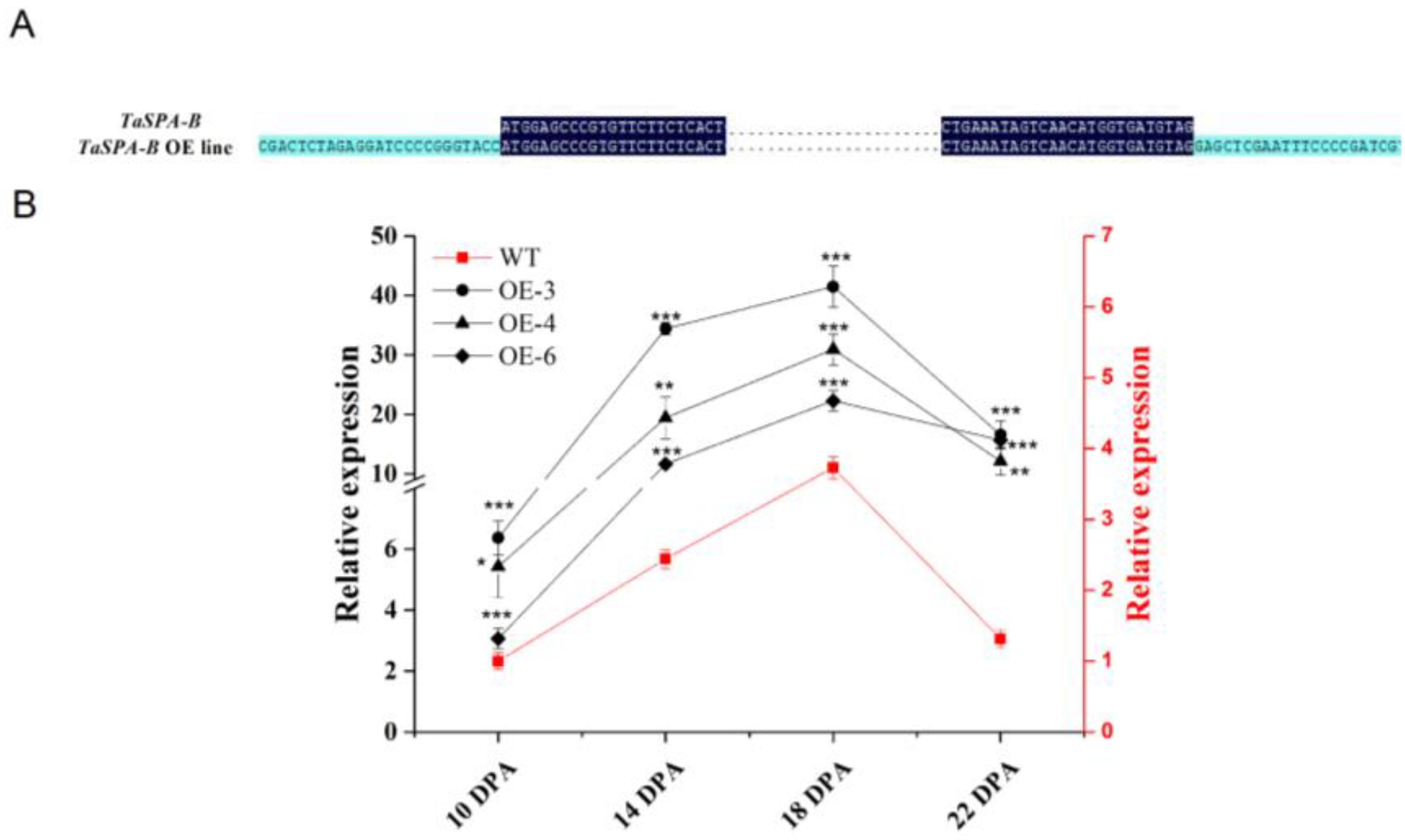
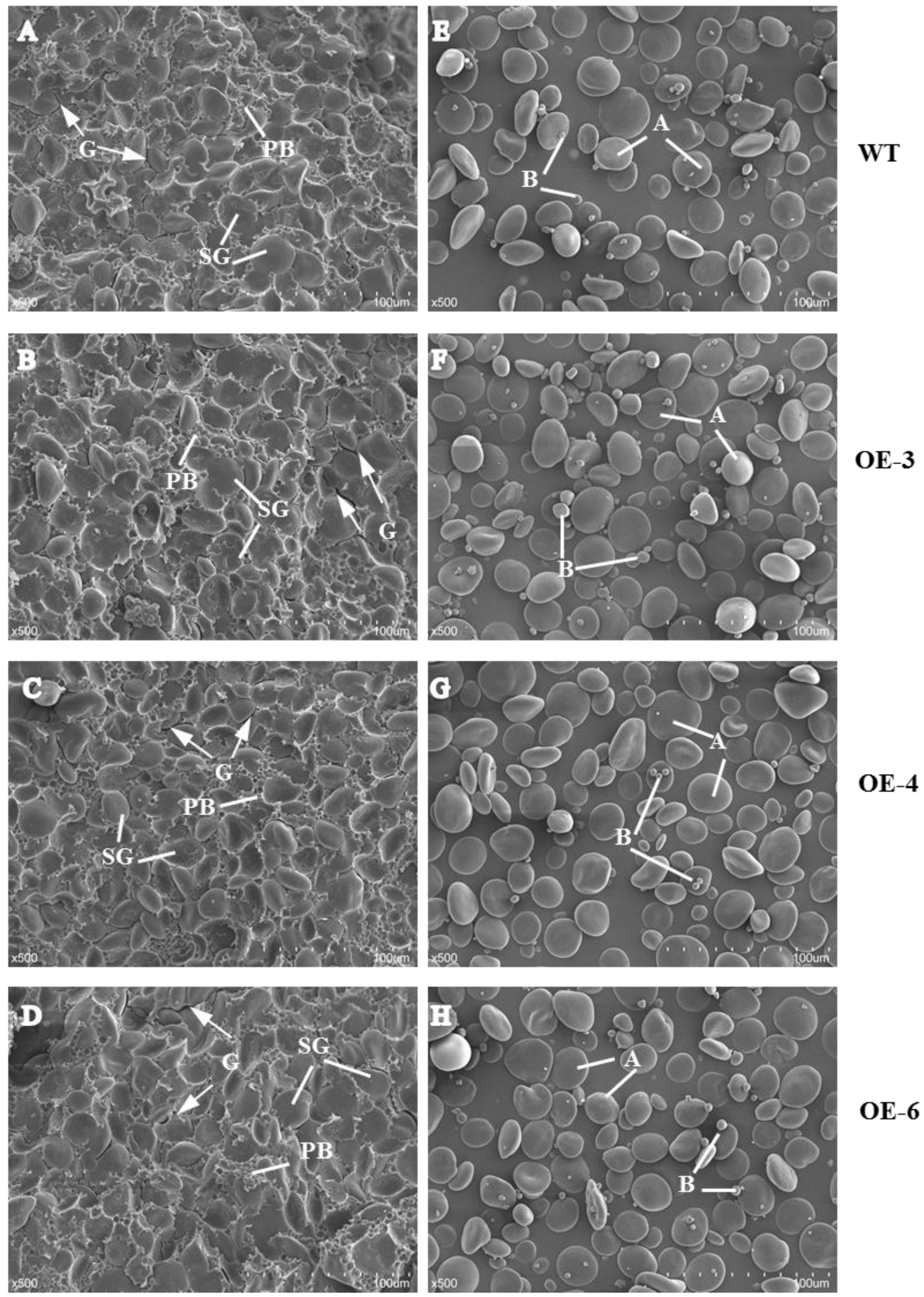
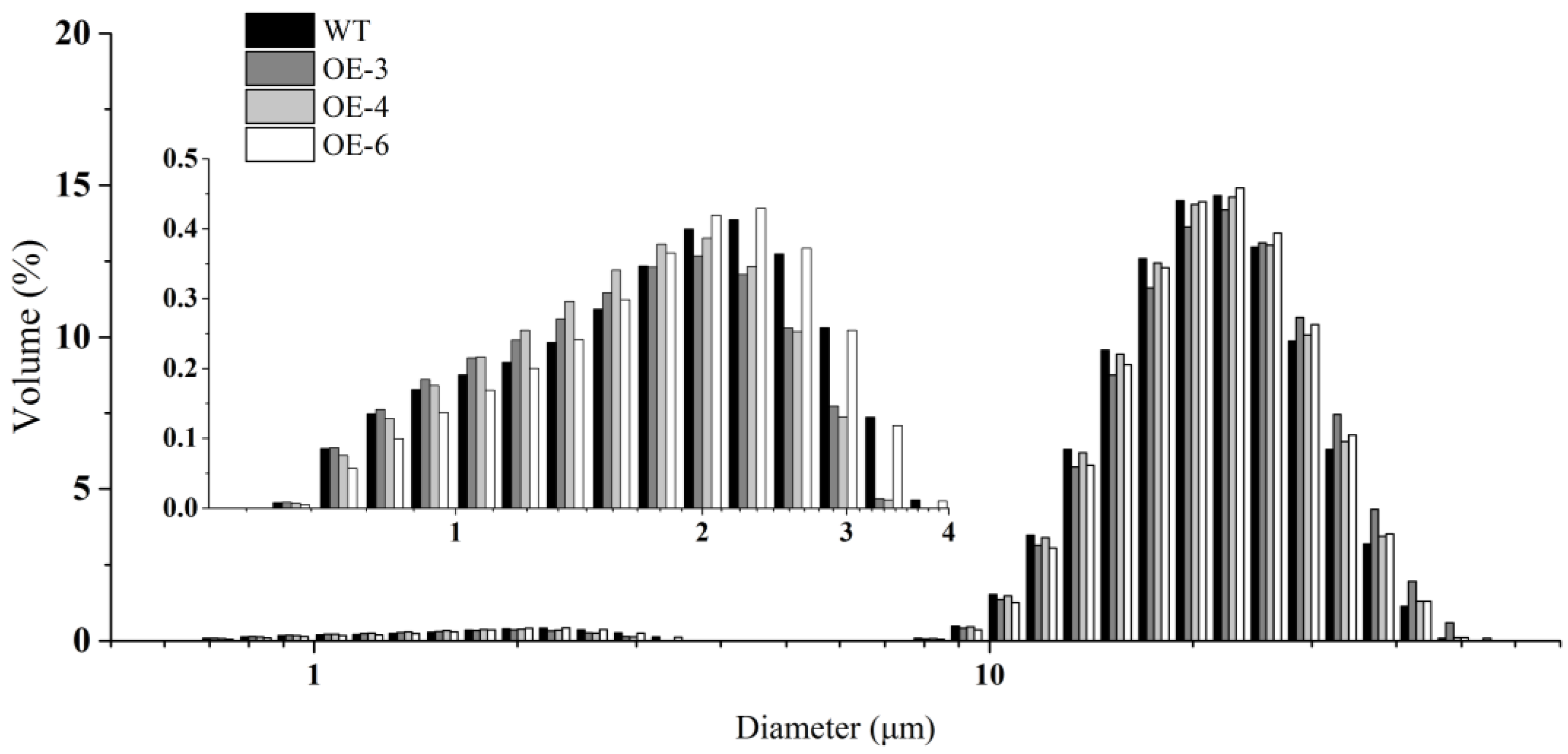
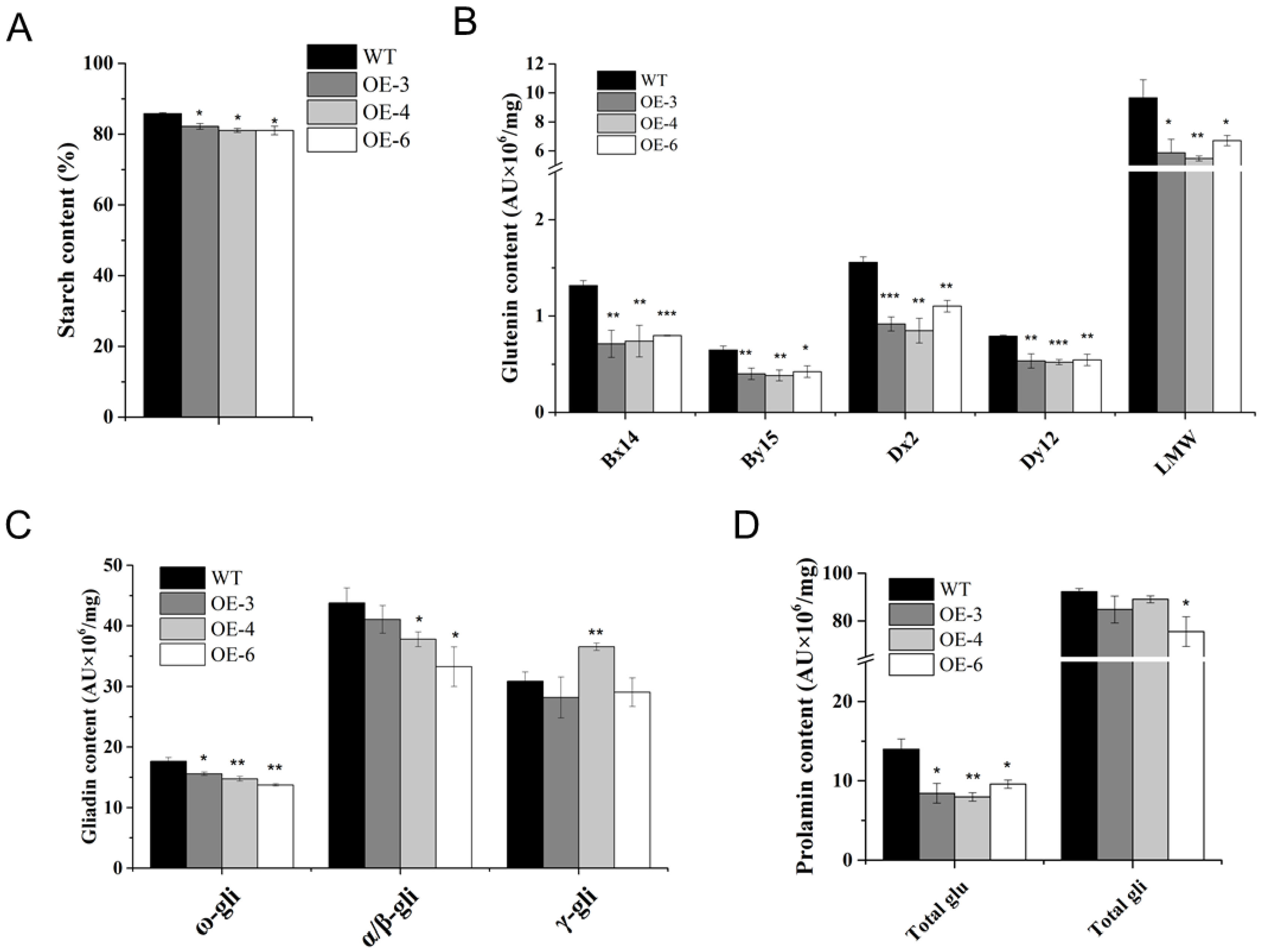
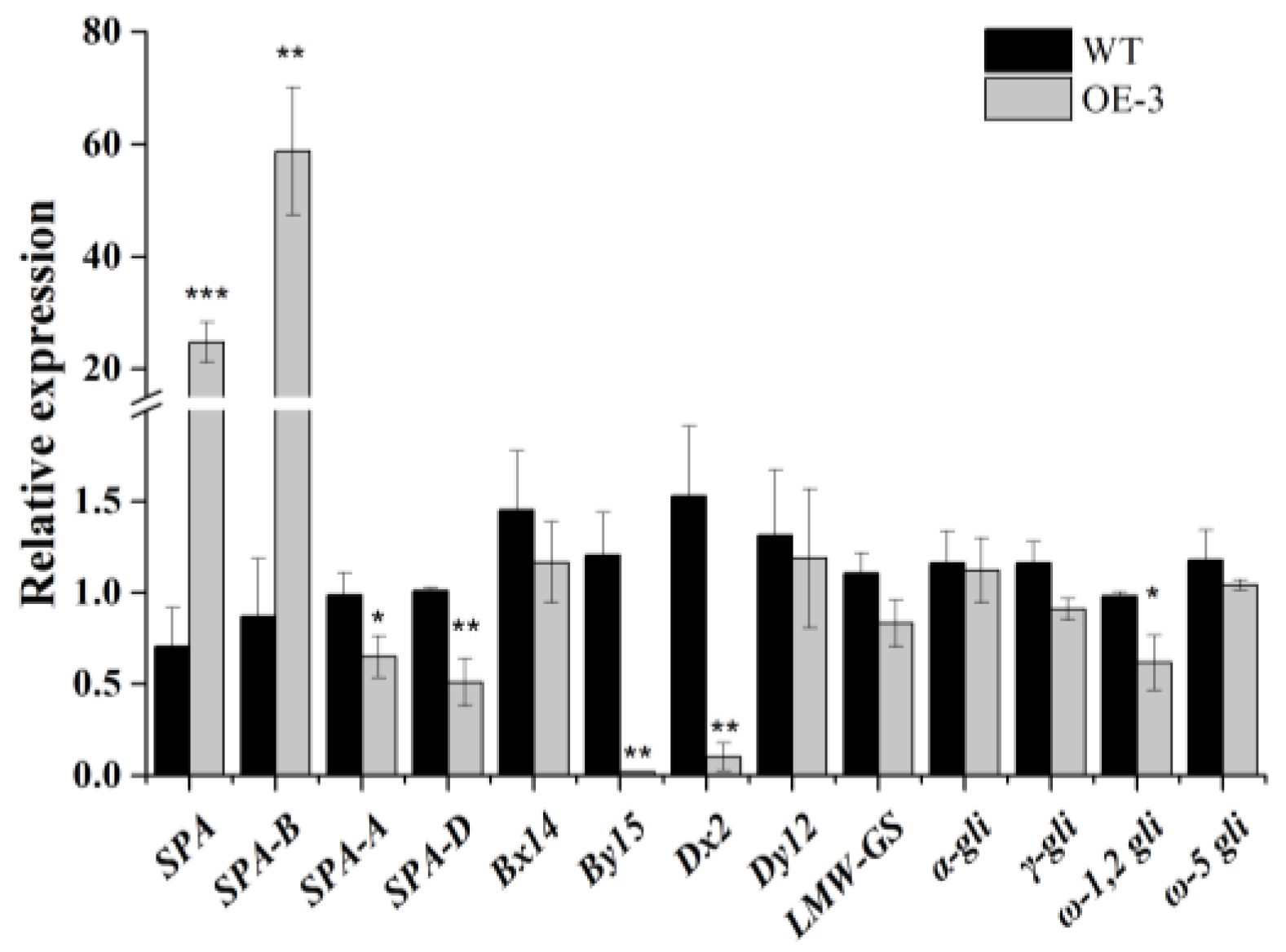
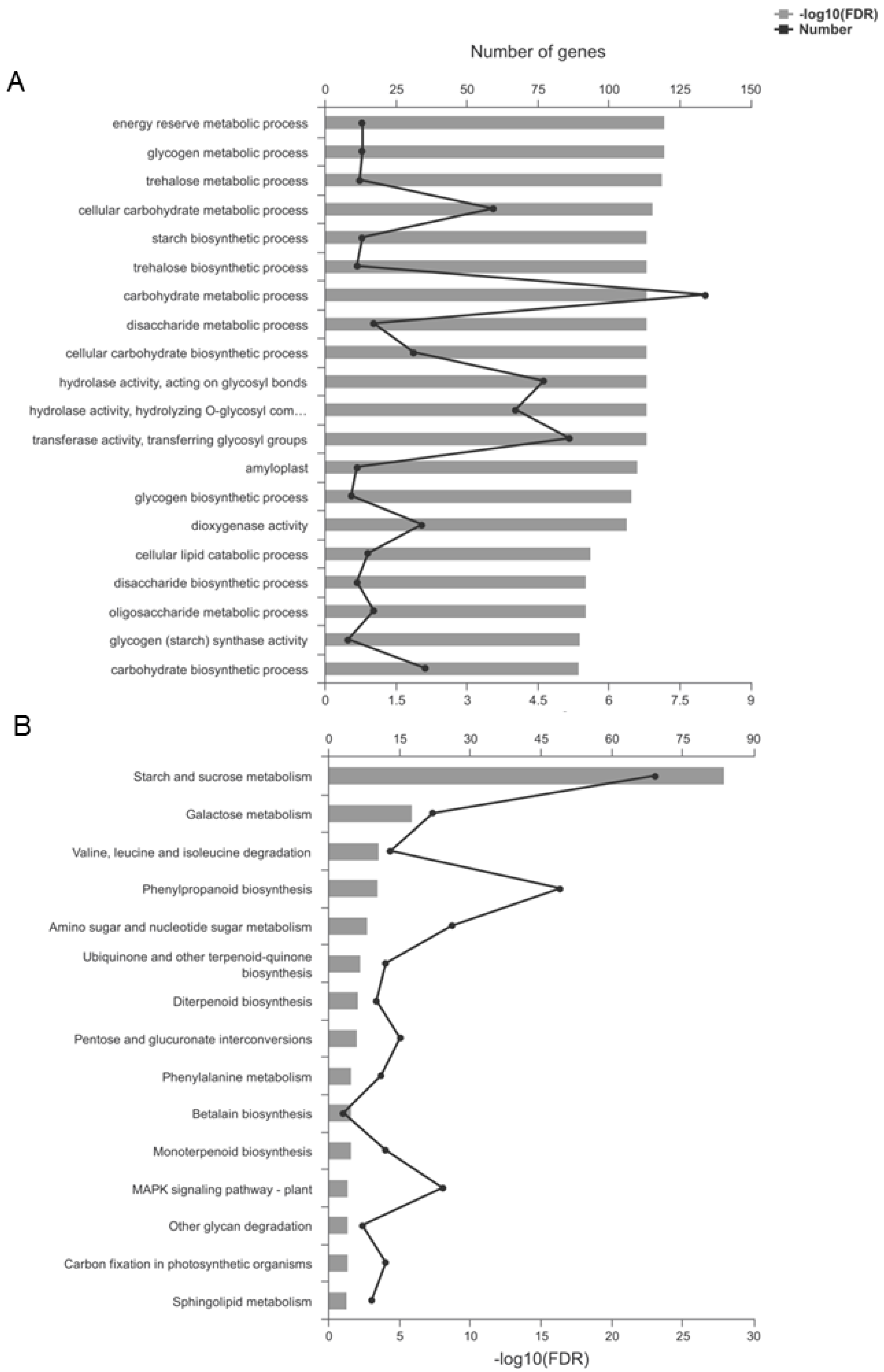
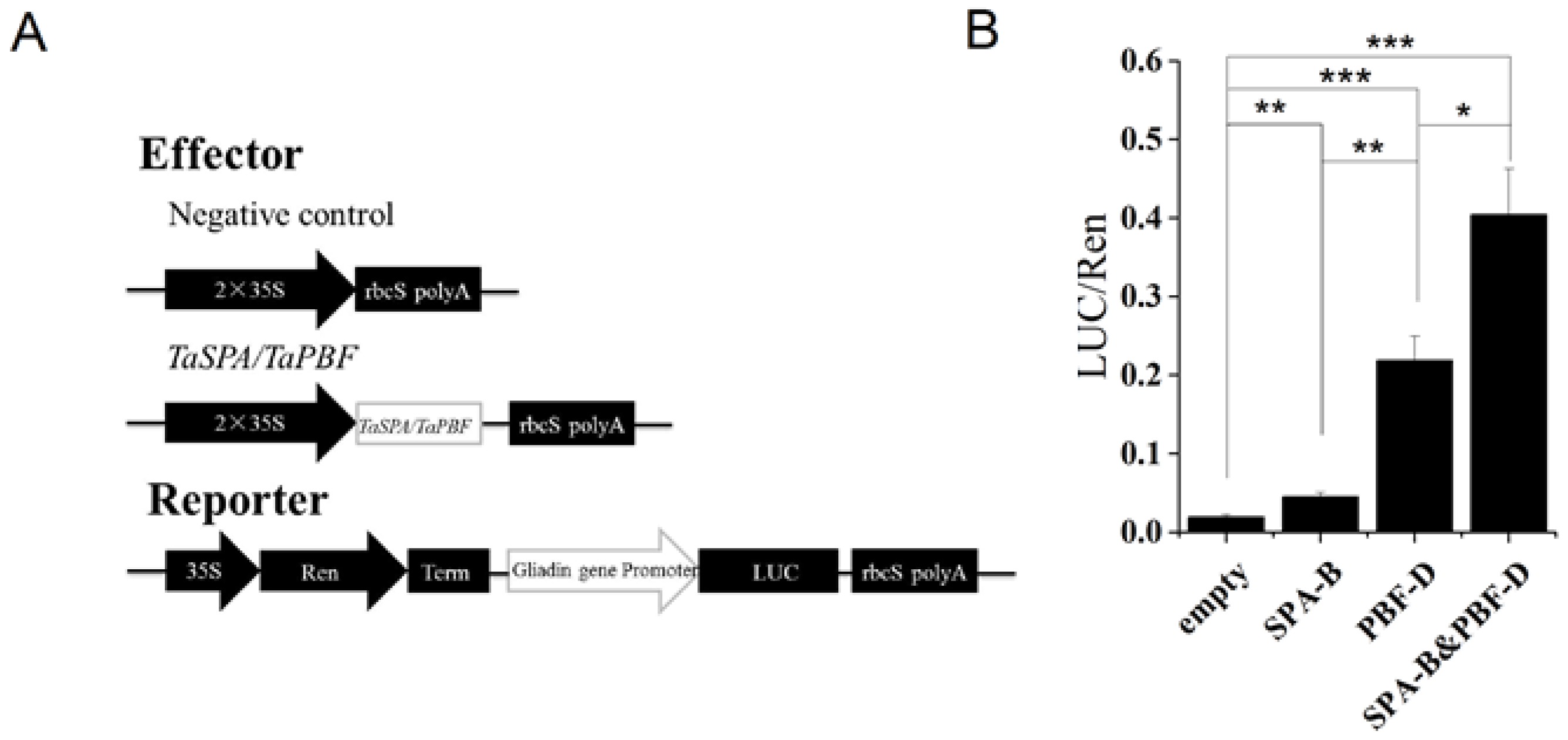
| Gene ID | Log2FC | Gene Name | Annotation |
|---|---|---|---|
| TraesCS1B02G264900 | 1.48 | PPDK | pyruvate orthophosphate dikinase |
| TraesCS1D02G252900 | 1.22 | PPDK | pyruvate orthophosphate dikinase |
| TraesCS1A02G099500 | 1.13 | pdhD | pyruvate dehydrogenase complex |
| TraesCS5A02G476700 | 2.40 | pdhC | pyruvate dehydrogenase complex |
| TraesCS5B02G116300 | 1.31 | pdhC | pyruvate dehydrogenase complex |
| TraesCS5D02G126000 | 1.55 | pdhC | pyruvate dehydrogenase complex |
| TraesCS4A02G446700 | −1.42 | SUSase | sucrose synthase |
| TraesCS2D02G403600 | −3.84 | SUSase | sucrose synthase |
| TraesCS2D02G175600 | −3.56 | SUSase | sucrose synthase |
| TraesCS2A02G406700 | −2.27 | SUSase | sucrose synthase |
| TraesCS2A02G168200 | −2.62 | SUSase | sucrose synthase |
| TraesCS2B02G194200 | −3.02 | SUSase | sucrose synthase |
| TraesCS5D02G182600 | −1.42 | ADPase | ADP-glucose pyrophosphorylase |
| TraesCS5D02G484500 | −1.72 | ADPase | ADP-glucose pyrophosphorylase |
| TraesCS5A02G472000 | −1.68 | ADPase | ADP-glucose pyrophosphorylase |
| TraesCS1B02G449700 | −1.05 | ADPase | ADP-glucose pyrophosphorylase |
| TraesCS7A02G287400 | −1.19 | ADPase | ADP-glucose pyrophosphorylase |
| TraesCS7D02G064300 | −1.44 | WAXY,GBSSI | granule bound starch synthase |
| TraesCS7A02G549300 | −1.64 | GBE1,SBE | starch branching enzyme |
| TraesCS2A02G310300 | −1.33 | GBE1,SBE | starch branching enzyme |
| TraesCS7A02G549100 | −1.24 | GBE1,SBE | starch branching enzyme |
| TraesCS2D02G308600 | −1.63 | GBE1,SBE | starch branching enzyme |
| TraesCS7D02G535600 | −2.68 | GBE1,SBE | starch branching enzyme |
| TraesCS7B02G472300 | −2.41 | GBE1,SBE | starch branching enzyme |
| TraesCS7B02G472500 | −1.09 | GBE1,SBE | starch branching enzyme |
| TraesCS7D02G117800 | −1.22 | SSI | soluble starch synthase |
| TraesCS7A02G120300 | −1.12 | SSI | soluble starch synthase |
| TraesCS7B02G093800 | −1.54 | SSII a | soluble starch synthase |
| TraesCS7A02G189000 | −1.43 | SS II a | soluble starch synthase |
| TraesCS7D02G190100 | −1.37 | SSII a | soluble starch synthase |
| TraesCS5A02G395200 | −1.98 | Pho1 | Alpha-1,4 glucan phosphorylase |
| TraesCS5B02G400000 | −1.48 | Pho1 | Alpha-1,4 glucan phosphorylase |
| TraesCS5D02G404500 | −1.70 | Pho1 | Alpha-1,4 glucan phosphorylase |
| TraesCS5B02G550300 | −1.31 | BAP31 | B-cell receptor-associated protein |
| TraesCS4A02G334800 | −1.11 | BAP31 | B-cell receptor-associated protein |
| TraesCS2B02G616300 | −2.77 | OST1, RPN1 | Ribophorin I |
| TraesCS2D02G566500 | −8.95 | OST1, RPN1 | Ribophorin I |
| TraesCS4A02G379700 | −1.45 | SKP1 | SKP1-like protein 1 |
| TraesCS1A02G133100 | −1.10 | HSPA1s | heat shock 70 kDa protein |
| TraesCS7B02G083100 | −1.81 | HSP20 | heat stress protein 20 |
| TraesCS5A02G257700 | −1.21 | HSP20 | heat stress protein 20 |
| TraesCS5D02G266000 | −1.31 | HSP20 | heat stress protein 20 |
| TraesCS7D02G179000 | 3.94 | HSP20 | heat stress protein 20 |
| TraesCS5A02G511800 | 6.42 | BIP | binding protein |
| TraesCS3A02G537600 | 1.37 | DNAJC3 | DnaJ homolog subfamily C member 3 |
| TraesCS3D02G543100 | 1.08 | DNAJC3 | DnaJ homolog subfamily C member 3 |
| TraesCS3D02G164900 | 1.38 | UBE2O | ubiquitin-conjugating enzyme E2 complex |
| TraesCS1A02G094100 | 3.31 | SIAH1 | ubiquitin-protein ligase E3 complex |
| TraesCS1D02G102700 | 2.32 | SIAH1 | ubiquitin-protein ligase E3 complex |
| TraesCS3A02G288900 | 1.47 | RCHY1 | ubiquitin-protein ligase E3 complex |
| TraesCS3A02G527600 | 1.50 | CDH1 | ubiquitin-protein ligase E3 complex |
| TraesCS5A02G177100 | 2.26 | UBE2D | ubiquitin-conjugating enzyme E2 complex |
| Gene ID | Log2FC | Gene Name |
|---|---|---|
| TraesCS1B02G343500 | 5.38 | TaSPA |
| TraesCS1D02G332200 | −1.51 | TaSPA |
| TraesCS5A02G155900 | −2.05 | TaPBF |
| TraesCS5B02G154100 | −2.19 | TaPBF |
| TraesCS5D02G161000 | −2.16 | TaPBF |
| TraesCS5A02G440400 | 1.07 | TaSHP |
| TraesCS5D02G447500 | 1.21 | TaSHP |
| TraesCS5B02G444100 | 1.04 | TaSHP, TabZIP1511 |
| TraesCS7B02G114300 | 3.69 | TabZIP229. 11 |
| TraesCS5D02G178800 | −1.02 | TabZIP167.21 |
| TraesCS1B02G076300 | −2.18 | TaRSR1 |
| TraesCS1A02G058400 | −2.63 | TaRSR1 |
| TraesCS1A02G409800 | 1.08 | TaGBF1 |
| TraesCS1B02G439800 | 1.20 | TaGBF1 |
| TraesCS1D02G417100 | 1.15 | TaGBF1 |
| TraesCS7A02G488600 | 5.84 | TabZIP194.31 |
| TraesCS7B02G391800 | 4.18 | TabZIP2061 |
| TraesCS7D02G475100 | 6.11 | TabZIP217.11 |
© 2020 by the authors. Licensee MDPI, Basel, Switzerland. This article is an open access article distributed under the terms and conditions of the Creative Commons Attribution (CC BY) license (http://creativecommons.org/licenses/by/4.0/).
Share and Cite
Guo, D.; Hou, Q.; Zhang, R.; Lou, H.; Li, Y.; Zhang, Y.; You, M.; Xie, C.; Liang, R.; Li, B. Over-Expressing TaSPA-B Reduces Prolamin and Starch Accumulation in Wheat (Triticum aestivum L.) Grains. Int. J. Mol. Sci. 2020, 21, 3257. https://doi.org/10.3390/ijms21093257
Guo D, Hou Q, Zhang R, Lou H, Li Y, Zhang Y, You M, Xie C, Liang R, Li B. Over-Expressing TaSPA-B Reduces Prolamin and Starch Accumulation in Wheat (Triticum aestivum L.) Grains. International Journal of Molecular Sciences. 2020; 21(9):3257. https://doi.org/10.3390/ijms21093257
Chicago/Turabian StyleGuo, Dandan, Qiling Hou, Runqi Zhang, Hongyao Lou, Yinghui Li, Yufeng Zhang, Mingshan You, Chaojie Xie, Rongqi Liang, and Baoyun Li. 2020. "Over-Expressing TaSPA-B Reduces Prolamin and Starch Accumulation in Wheat (Triticum aestivum L.) Grains" International Journal of Molecular Sciences 21, no. 9: 3257. https://doi.org/10.3390/ijms21093257
APA StyleGuo, D., Hou, Q., Zhang, R., Lou, H., Li, Y., Zhang, Y., You, M., Xie, C., Liang, R., & Li, B. (2020). Over-Expressing TaSPA-B Reduces Prolamin and Starch Accumulation in Wheat (Triticum aestivum L.) Grains. International Journal of Molecular Sciences, 21(9), 3257. https://doi.org/10.3390/ijms21093257





